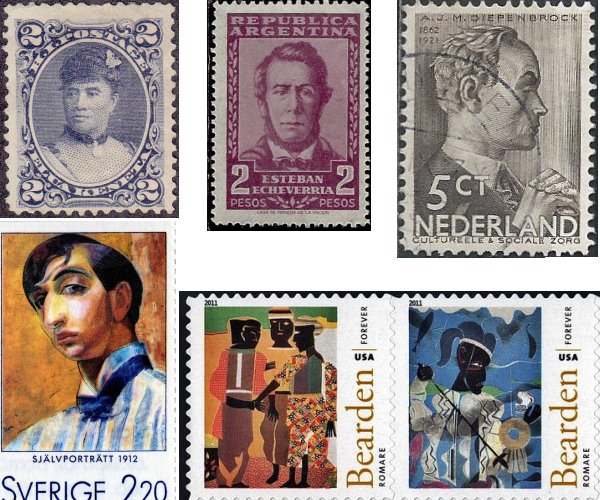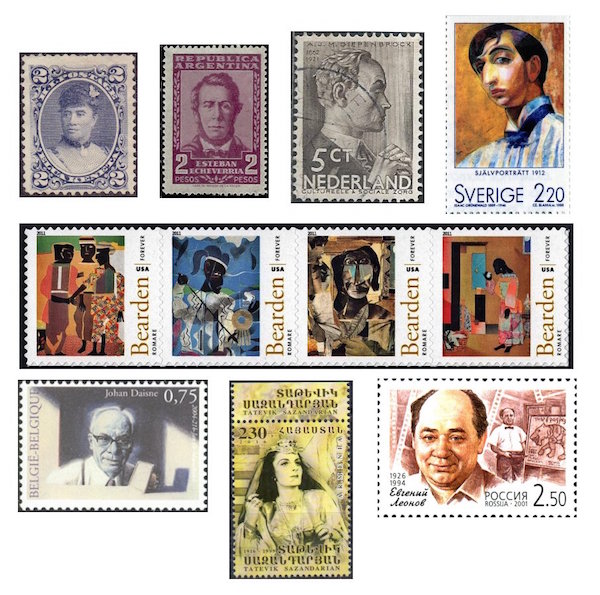The Arts on Stamps of the World — September 2
An Arts Fuse regular feature: the arts on stamps of the world.

By Doug Briscoe
Did you know that the famous song “Aloha ‘Oe” was composed by royalty? And this was not just a “one-off”. Queen Lili‘uokalani (Lydia Lili‘u Loloku Walania Wewehi Kamaka‘eha, to give her her full due), the last reigning monarch of the Kingdom of Hawaii, wrote about 165 songs, blending traditional elements with Western harmonies. She sang and played multiple instruments—besides the native ukelele, she was said to be accomplished on the piano, organ, zither, and guitar. Sadly, and likely unjustly, she was implicated in a counter-coup attempt against the provisional government that had overthrown her in 1893 and was placed under arrest. Upon her being pardoned, she visited Brookline, Massachusetts, where her American husband’s cousins lived, and began work on her book Hawaii’s Story by Hawaii’s Queen. Lili‘uokalani was born on September 2, 1838 and died one hundred years ago on November 11, 1917. As for the philatelic angle, the Kingdom of Hawaii issued its own stamps between 1851 and 1891; thereafter the provisional government issued them until the islands were annexed to the United States in 1898. (The earliest Hawaiian stamp, the 2-cent so-called “Missionary” issue, is among the rarest and most valuable in the world.) The Queen appears on three later stamps (a single design) issued between 1890 and 1893.
The Argentine writer and political activist Esteban Echeverría (September 2, 1805 – January 19, 1851) spent five formative years in Paris at the height of the Romantic movement in the arts, and he brought that influence, with its political undertones, back to Argentina in 1831. He wrote poetry and helped form the literary institution Asociación de Mayo in 1840. That year he was forced into exile and spent his remaining years in Uruguay. Perhaps his most important work is not a poem but rather a short story called “El matadero” (“The Slaughter Yard”), symbolic of the cultural clash between Europe and the Americas.
September 2nd is also the birthday of Dutch composer Alphons Diepenbrock (1862 – 5 April 1921). Though highly educated, indeed a person of Protean intellectual accomplishment (he wrote his doctoral thesis on the life of Seneca in Latin and published works on literature, painting, politics, philosophy, and religion), he was largely self-taught in music. Wikipedia informs us: “He created a musical idiom which, in a highly personal manner, combined 16th-century polyphony with Wagnerian chromaticism, to which in later years was added the impressionistic refinement that he encountered in Debussy’s music.” Most of his music is vocal, but two albums of his rewarding orchestral music, with and without vocal soloists, came out on the Chandos label in 1989-90.
Just two days after remembering the German master Matthias Grünewald, we celebrate the birthday of his namesake Isaac Grünewald (2 September 1889 – 22 May 1946), another painter (and an important one)! He was one of the first to introduce modernism to Sweden. Born in a Stockholm to a Jewish family, he studied in Paris from 1908 alongside his future wife, the painter Sigrid Hjertén. They exhibited together, but strong anti-Semitism and male chauvinism led to their consistently being lambasted in the press. Grünewald, indeed, was the primary target of anti-Semitic Swedish press from 1910 to 1926! This did not prevent the young couple from artistic success. Grünewald was commissioned to create stage designs for opera and theater and to paint frescoes for prominent buildings in Stockholm; he taught at the Royal Swedish Academy of Arts and was one of the first recipients of the Prince Eugen Medal on its inception in 1945. Tragically, Hjertén had to be committed to a mental institution, and Grünewald was killed in an airplane crash with his second wife. The Swedish stamp of 1988 gives us his Self-Portrait of 1912.

Six years ago, for the centennial of his birth, Afro-American artist Romare Bearden (September 2, 1911 – March 12, 1988) was honored with a set of four stamps of selected art works. Though born in Charlotte, North Carolina, Bearden grew up in the rich environment of the Harlem Renaissance. His mother was politically active and a journalist. He went to schools in Pennsylvania and to BU besides attending NYU and worked on the journals of the latter two institutions. At the Art Students League he was a student of George Grosz and drew cartoons for African-American newspapers. Over the course of his art career he worked in a variety of media, mainly oils and collage. He was also a songwriter who co-authored the song “Sea Breeze”, recorded by his former schoolmate Billy Eckstine and Dizzy Gillespie. Bearden served in the army in World War II from 1942 to 1945. The stamps show his pieces Conjunction (1979), Poseidon, The Sea God-Enemy of Odysseus (1977, from the Odysseus series), Prevalance of Ritual : Conjur Woman (1964), and Falling Star (1979-80).
Flemish writer Herman Thiery (2 September 1912–9 August 1978) began using the pseudonym Johan Daisne in 1935 with his first volume of poetry. He also wrote novels that were among the earliest to introduce magic realism to Dutch literature. Besides also creating screenplays and radio plays, Daisne assembled a three-volume Filmographic Dictionary of World Literature (1971) in four languages.
Last year was the centennial of the birth of Armenian mezzo-soprano Tatevik Sazandarian (2 September [20 August O.S.] 1916 – 6 October 1999). She was known for her roles in operas by Armenian composers such as Spendiaryan but was also celebrated for her interpretations of Amneris, Dalila, and leading characters in Rimsky-Korsakov’s Tsar’s Bride and Borodin’s Prince Igor. Sazandarian taught at Yerevan Conservatory from 1961.
Another Soviet artist, but a Russian this time, was actor Yevgeny Leonov (2 September 1926 – 29 January 1994), who played roles in a number of important Soviet films between 1949 and 1993 and was also a voice actor for cartoons. He specialized in comic parts but also acted in dramatic roles. Leonov won a Best Actor award at the Venice Film Festival for his performance in Autumn Marathon (1980).
A graduate of the University of Massachusetts with a B.A. in English, Doug Briscoe worked in Boston classical music radio, at WCRB, WGBH, and WBUR, for about 25 years, beginning in 1977. He has the curious distinction of having succeeded Robert J. Lurtsema twice, first as host of WGBH’s weekday morning classical music program in 1993, then as host of the weekend program when Robert J.’s health failed in 2000. Doug also wrote liner notes for several of the late Gunther Schuller’s GM Recordings releases as well as program notes for the Boston Classical Orchestra. For the past few years he’s been posting a Facebook “blog” of classical music on stamps of the world, which has now been expanded to encompass all the arts for The Arts Fuse.
